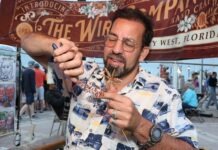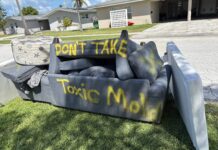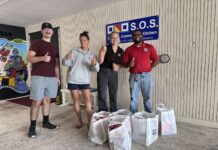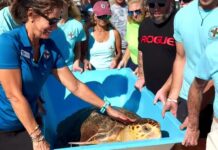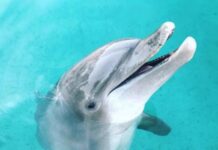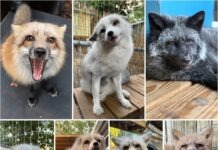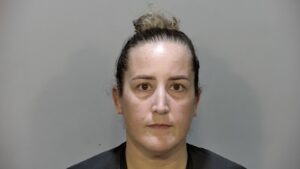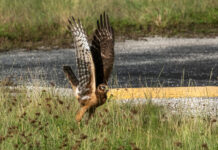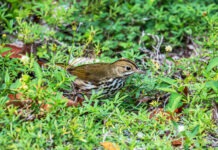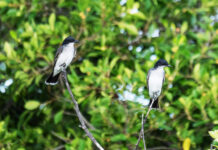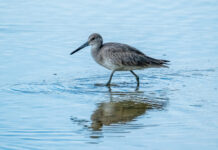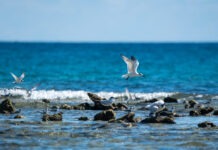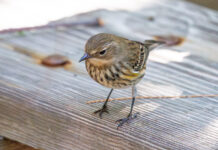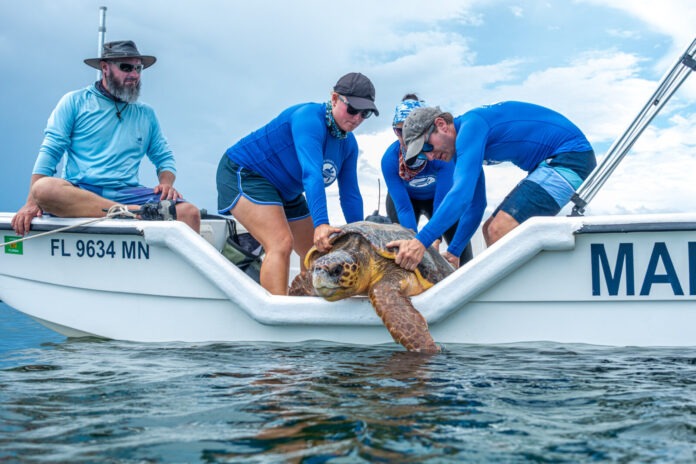
Loggerhead turtles are called that because their disproportionately large heads reminded people in the 1700s of a logger, which was a big chunk of wood used to hobble a horse. And it was those big chunky loggerhead heads we were looking for.
“We” might be an overstatement. I was sitting on a cooler, taking notes, down below Ryan Welsh, who was driving the boat from up in the tuna tower. Caitlin Lustic, who worked for the Nature Conservancy and, like me, was along for the ride, was up there with him. Ryan worked for Inwater Research Group, along with Aaron Garstin, Yvette Fernandez and Ness Michaels, who were all standing on the bow of the customized 24-foot Carolina Skiff. (There was a short, Festivus-style pole inserted into the elevated deck that they could grab onto for balance.)
Inwater is a nonprofit based out of Jensen Beach in the Port St. Lucie area. Where most sea turtle study is done when females come up onto beaches to nest, Inwater, as the name suggests, specializes in studying turtles in the water, especially males. They have five main research spots around the state and have worked in the Keys since 2004.
Everyone had their eyes peeled left, right and center as Ryan drove through a slow search pattern I couldn’t quite follow between Little Pine Key and the Johnson Keys.
It was relatively bright, with clouds coming in occasionally, but then drifting off. We could see big, dark storm clouds both toward Key West and Marathon, but we seemed to be in the clear. At least for a while.
After about a half hour, Ness yelled, “Loggerhead. Left side,” and everyone went into action.
Ness and Yvette geared up with snorkels, masks and fins. Aaron went to the depth finder and read out numbers in meters. “One-point-four. One. One-point seven.”
Ryan slowly drifted the boat up to a pale shape below the surface that Ness was pointing at. Ness dove in.
More than a few seconds later she popped up, holding several hundred pounds of turtle by the back of its shell, the way you’d hold a fussy toddler. Ness swam slowly toward a dip in the boat’s gunwale, and when she was close enough, Yvette and Aaron carefully grabbed the loggerhead by the armpits (flipper pits?) and pulled the turtle in.
I was advised to be careful of my toes, as it was something the turtle could chomp on and do some damage.
In Australia, where this technique of catching large, hard-shelled marine reptiles was devised, the process is generally called a turtle rodeo. But the Inwater folks prefer the term rodeo capture because it reflected more the science-based reasons for the capture, and probably because it sounded a little less yeehaw.
The crew had put a pad down on the deck, and the turtle was half off and half on it. It slapped his flippers, spinning and moving in jerky movements. Occasionally he would let out a loud breath.
“This is a young one. A subadult. Basically a teenage turtle,” Ness said. Though not a mutant.
The shell was covered with a thin layer of algae and a few barnacles.
“Loggerheads are crusty,” Ness said. “They tend to sit on the bottom a lot. They’re very slow moving as far as sea turtles go. They just kind of sit in the muck and everything grows on them. But it’s a healthy load of epibionts.”
Epibionts are living things that make their home on a turtle’s shell.
The first thing they did was scan the turtle with a wand, looking for a subdermal chip similar to what dogs and cats get at the vet, in case it had been captured before. When they didn’t find one, they inserted a chip of their own.
The turtle was too young to know its sex, but they might be able to tell later by a blood sample they took.
They took a biopsy for genetic data, attached metal tags to the inside of the two front flippers, measured it and weighed it in a sling.
Fifty-six-point-seven kilograms, or 125 pounds in real numbers.
They checked the turtle’s mouth for growth, hooks, plastic ingestion – anything that would cause them to take it to a rehabilitation facility.
Then they slid the turtle to the cutout, and gently slipped it back into the water.
Ryan started the search pattern again. Less than 20 minutes later, it was Yvette diving off the bow, disappearing, coming up with an even larger loggerhead.
This one was a young adult, male, by the large tail, weighing a little over 86 kilograms, or 160 pounds. They dubbed him Hawk, in honor of it being hawk migration season in the Keys.
This was the crew’s sixth and last day on this trip. They’d brought six satellite tags, each costing about $5,000, with them, and had attached five of them to loggerheads, which they considered a success. Hawk was large enough that they could now attach their last one, making the trip even more of a success.
They pulled a Bimini over the deck and got to work.
Hawk, like his young predecessor, was slapping, spinning, sliding, making noises similar to what my dog makes when she snores. They clocked that he was missing about 45% of a back flipper, possibly from a shark attack.
He was tagged, sampled, measured. Then they went to work scrubbing a clear spot on the carapace, then sanding it with fine grain paper, to get rid of any loose flakes on the keratin shell. The sanding seemed to calm Hawk, like he was having a spa day. They said that’s how most turtles respond.
They glued the satellite tag, a wedge-shaped box that was about six inches long with an antenna on top, onto the shell, then edged it with epoxy, then covered it in marine paint to keep the algae and barnacles off. The whole process took about 40 minutes.
Ness said the tags usually lasted about six months before they were shed, but they currently had a turtle whose tag had stayed attached for 16 months.
“With our research site out here in the Johnson Keys the cool thing we’re finding is that there is a very high density of these male loggerheads. We don’t see that at any of our other research sites. Which is why we’re coming out here putting the satellite tags on these males,” said Ness.
Ryan said the male loggerheads come to the area after their “lost years,” which are five or 10 years after they hatch on distant beaches and disappear out into the middle of the ocean.
“They actually stay out longer than other species. But then once they get biggish, they’ll start to come in and they’ll try to establish a residency somewhere. So this is a really common area for them,” Ryan said. “They appear to have high site fidelity.”
Part of what they are hoping to learn from these trackers, is where the males meet up with the females to mate.
“They do undertake a breeding migration when they’re adults. When they’re immature and not fully grown, they tend to just hang out here,” Ryan said.
When the marine paint was dry, they slid the hawk to the gap in the gunwale and let him slip back into the water.The satellite tag is already sending tracking data. You can see it, along with the tracks of several other turtles, at inwater.org/research/trackingseaturtles/.

